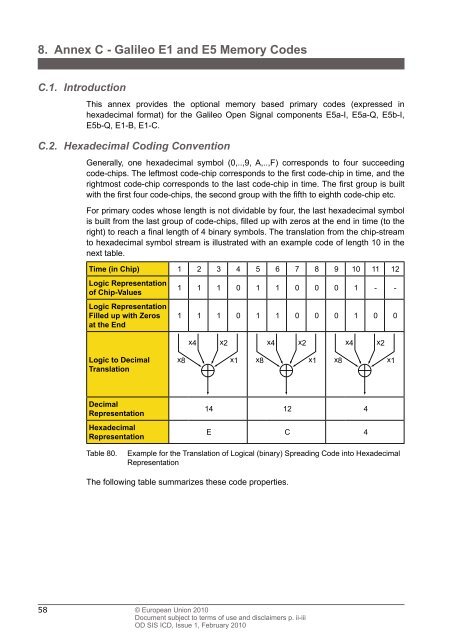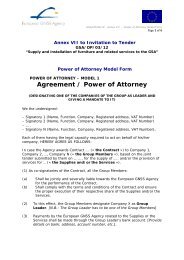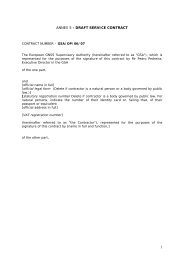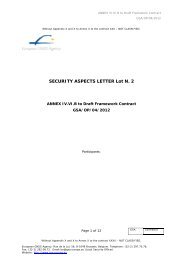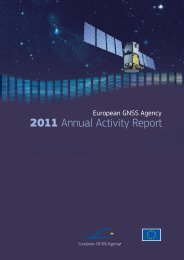Galileo OS SIS ICD.indd - GSA - Europa
Galileo OS SIS ICD.indd - GSA - Europa
Galileo OS SIS ICD.indd - GSA - Europa
Create successful ePaper yourself
Turn your PDF publications into a flip-book with our unique Google optimized e-Paper software.
8. Annex C - <strong>Galileo</strong> E1 and E5 Memory Codes<br />
C.1. Introduction<br />
This annex provides the optional memory based primary codes (expressed in<br />
hexadecimal format) for the <strong>Galileo</strong> Open Signal components E5a-I, E5a-Q, E5b-I,<br />
E5b-Q, E1-B, E1-C.<br />
C.2. Hexadecimal Coding Convention<br />
Generally, one hexadecimal symbol (0,..,9, A,..,F) corresponds to four succeeding<br />
code-chips. The leftmost code-chip corresponds to the fi rst code-chip in time, and the<br />
rightmost code-chip corresponds to the last code-chip in time. The fi rst group is built<br />
with the fi rst four code-chips, the second group with the fi fth to eighth code-chip etc.<br />
For primary codes whose length is not dividable by four, the last hexadecimal symbol<br />
is built from the last group of code-chips, fi lled up with zeros at the end in time (to the<br />
right) to reach a fi nal length of 4 binary symbols. The translation from the chip-stream<br />
to hexadecimal symbol stream is illustrated with an example code of length 10 in the<br />
next table.<br />
Time (in Chip) 1 2 3 4 5 6 7 8 9 10 11 12<br />
Logic Representation<br />
of Chip-Values<br />
Logic Representation<br />
Filled up with Zeros<br />
at the End<br />
Logic to Decimal<br />
Translation<br />
Decimal<br />
Representation<br />
Hexadecimal<br />
Representation<br />
1 1 1 0 1 1 0 0 0 1 - -<br />
1 1 1 0 1 1 0 0 0 1 0 0<br />
x4 x2<br />
x8 x1<br />
x4 x2<br />
x8 x1<br />
14 12 4<br />
E C 4<br />
58 © European Union 2010<br />
Document subject to terms of use and disclaimers p. ii-iii<br />
OD <strong>SIS</strong> <strong>ICD</strong>, Issue 1, February 2010<br />
x4 x2<br />
x8 x1<br />
Table 80. Example for the Translation of Logical (binary) Spreading Code into Hexadecimal<br />
Representation<br />
The following table summarizes these code properties.


